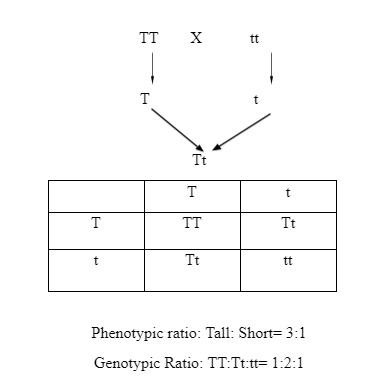Introduction
Gregor Johan Mendel is considered the father of genetics who first introduced both monohybrid and dihybrid cross. Mendel chose pea plants as their genes do not show the property of linkage. He formulated his two laws, the law of segregation and the law of independent assortment based on monohybrid cross and dihybrid cross respectively. Monohybrid cross, mainly, considers one character and forms a single hybrid whereas dihybrid crosses considers two characters.
Terms Related to Crossing
Filial Generation: This represents the generation in an experiment which is successive to the parental generation where the considered parents are purely homozygous.
Punnett Square: Punnett square represents a table in which one can represents all possible outcomes in a mating two individuals with known genotype.
Hybrid: The organisms which can be obtained by mating two different species or variants are known as hybrid.
Homozygous: Presence of two equal alleles of a gene in a same locus can be termed as homozygous.
Heterozygous: Presence of two different alleles of a gene, one dominant, and one recessive in the same locus can be termed as heterozygous.
Definition of Monohybrid and Dihybrid Cross
Monohybrid cross refers to the genetic cross which involves mating of two homozygous individuals consisting of a single character present in a single locus.
Dihybrid cross highlights the genetic cross which consists of the mating of two homozygous individuals considering two non-linked characters present in different loci.
Difference Between Monohybrid and Dihybrid Cross
Subject | Monohybrid Cross | Dihybrid Cross |
Definition | Monohybrid cross refers to the genetic cross which involves mating of two homozygous individuals consisting of a single character present in a single locus. | Dihybrid cross highlights the genetic cross which consists of the mating of two homozygous individuals considering two non-linked characters present in different loci. |
Number of Characters | Only one character is taken into consideration. | Two characters of different loci are considered. |
Pair of genes | One pair of genes is involved. | Two pairs of genes are involved. |
Phenotypic ratio | The anticipated phenotypic ratio is 3:1 | The anticipated phenotypic ratio is 9:3:3:1 |
Law | The Law of segregation was formulated based on the monohybrid cross. | The law of independent assortment was formulated based on the dihybrid cross. |
Genotypic ratio | The anticipated genotypic ratio includes 1:2:1 | The anticipated genotypic ratio includes 1:2:2:4:1:2:1:2:1 |
Test cross | Test cross-ratio is 1:1 | Test cross-ratio is 1:1:1:1 |
Example of Monohybrid and Dihybrid Cross
Monohybrid cross: One of the most common examples of a monohybrid cross is the cross done by Mendel by considering 7 contrasting characters of the pea plants.
Huntington’s disease can be considered as another example which is a fatal genetic disorder, dominant. In this disease, the gene is present within each human being in a single generation. One dominant allele mates with a homozygous recessive allele will form a monohybrid individual and the dominant allele will get carried to the next generation.
Here, “T” represents the alleles of the gene which influences the tallness of the plant. TT represents the homozygous dominant allele whereas tt represents the homozygous recessive allele. Tt represents the heterozygous gene.

Dihybrid cross: The most common example of a dihybrid cross is the cross performed by Mendel by considering two non-linked characters. He crossed yellow coloured round seed with green coloured wrinkled seed. This crossing produced hybrid yellow coloured round seed and gives four phenotypes in the ratio 9:3:3:1 in the second filial generation.
Here, “Y” represents the yellow coloured seed and “R” represents round seed. Therefore, YYRR represents the dominant homozygous condition and represents the yellow coloured round seed. yyrr represents the recessive homozygous individual, represents the green coloured wrinkled seed. YyRr represents the heterozygous condition which also represents the yellow coloured round seed.
YR | Yr | yR | yr | |
YR | YYRR | YYRr | YyRR | YyRr |
Yr | YYRr | YYrr | YyRr | Yyrr |
yR | YyRR | YyRr | yyRR | yyRr |
yr | YyRr | Yyrr | yyRr | yyrr |
Genotypic Ratio: 1:2:2:4:1:2:1:2:1
Phenotypic Ratio: 9:3:3:1
Conclusion
Gregor Johan Mendel is considered the father of genetics who first introduced both monohybrid and dihybrid cross. Monohybrid cross refers to the genetic cross which involves mating of two homozygous individuals consisting of a single character present in a single locus. Dihybrid cross highlights the genetic cross which consists of the mating of two homozygous individuals considering two non-linked characters present in different loci. Mendel formulated his two laws, the law of segregation and the law of independent assortment based on monohybrid cross and dihybrid cross respectively.
 Profile
Profile Settings
Settings Refer your friends
Refer your friends Sign out
Sign out







